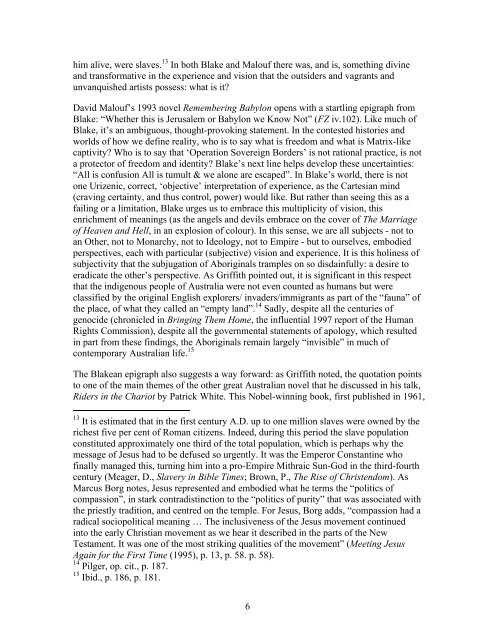William-Blake-and-the-Indigenous-Imagination-A-Review
William-Blake-and-the-Indigenous-Imagination-A-Review
William-Blake-and-the-Indigenous-Imagination-A-Review
You also want an ePaper? Increase the reach of your titles
YUMPU automatically turns print PDFs into web optimized ePapers that Google loves.
him alive, were slaves. 13 In both <strong>Blake</strong> <strong>and</strong> Malouf <strong>the</strong>re was, <strong>and</strong> is, something divine<br />
<strong>and</strong> transformative in <strong>the</strong> experience <strong>and</strong> vision that <strong>the</strong> outsiders <strong>and</strong> vagrants <strong>and</strong><br />
unvanquished artists possess: what is it?<br />
David Malouf’s 1993 novel Remembering Babylon opens with a startling epigraph from<br />
<strong>Blake</strong>: “Whe<strong>the</strong>r this is Jerusalem or Babylon we Know Not” (FZ iv.102). Like much of<br />
<strong>Blake</strong>, it’s an ambiguous, thought-provoking statement. In <strong>the</strong> contested histories <strong>and</strong><br />
worlds of how we define reality, who is to say what is freedom <strong>and</strong> what is Matrix-like<br />
captivity? Who is to say that ‘Operation Sovereign Borders’ is not rational practice, is not<br />
a protector of freedom <strong>and</strong> identity? <strong>Blake</strong>’s next line helps develop <strong>the</strong>se uncertainties:<br />
“All is confusion All is tumult & we alone are escaped”. In <strong>Blake</strong>’s world, <strong>the</strong>re is not<br />
one Urizenic, correct, ‘objective’ interpretation of experience, as <strong>the</strong> Cartesian mind<br />
(craving certainty, <strong>and</strong> thus control, power) would like. But ra<strong>the</strong>r than seeing this as a<br />
failing or a limitation, <strong>Blake</strong> urges us to embrace this multiplicity of vision, this<br />
enrichment of meanings (as <strong>the</strong> angels <strong>and</strong> devils embrace on <strong>the</strong> cover of The Marriage<br />
of Heaven <strong>and</strong> Hell, in an explosion of colour). In this sense, we are all subjects - not to<br />
an O<strong>the</strong>r, not to Monarchy, not to Ideology, not to Empire - but to ourselves, embodied<br />
perspectives, each with particular (subjective) vision <strong>and</strong> experience. It is this holiness of<br />
subjectivity that <strong>the</strong> subjugation of Aboriginals tramples on so disdainfully: a desire to<br />
eradicate <strong>the</strong> o<strong>the</strong>r’s perspective. As Griffith pointed out, it is significant in this respect<br />
that <strong>the</strong> indigenous people of Australia were not even counted as humans but were<br />
classified by <strong>the</strong> original English explorers/ invaders/immigrants as part of <strong>the</strong> “fauna” of<br />
<strong>the</strong> place, of what <strong>the</strong>y called an “empty l<strong>and</strong>”. 14 Sadly, despite all <strong>the</strong> centuries of<br />
genocide (chronicled in Bringing Them Home, <strong>the</strong> influential 1997 report of <strong>the</strong> Human<br />
Rights Commission), despite all <strong>the</strong> governmental statements of apology, which resulted<br />
in part from <strong>the</strong>se findings, <strong>the</strong> Aboriginals remain largely “invisible” in much of<br />
contemporary Australian life. 15<br />
The <strong>Blake</strong>an epigraph also suggests a way forward: as Griffith noted, <strong>the</strong> quotation points<br />
to one of <strong>the</strong> main <strong>the</strong>mes of <strong>the</strong> o<strong>the</strong>r great Australian novel that he discussed in his talk,<br />
Riders in <strong>the</strong> Chariot by Patrick White. This Nobel-winning book, first published in 1961,<br />
13 It is estimated that in <strong>the</strong> first century A.D. up to one million slaves were owned by <strong>the</strong><br />
richest five per cent of Roman citizens. Indeed, during this period <strong>the</strong> slave population<br />
constituted approximately one third of <strong>the</strong> total population, which is perhaps why <strong>the</strong><br />
message of Jesus had to be defused so urgently. It was <strong>the</strong> Emperor Constantine who<br />
finally managed this, turning him into a pro-Empire Mithraic Sun-God in <strong>the</strong> third-fourth<br />
century (Meager, D., Slavery in Bible Times; Brown, P., The Rise of Christendom). As<br />
Marcus Borg notes, Jesus represented <strong>and</strong> embodied what he terms <strong>the</strong> “politics of<br />
compassion”, in stark contradistinction to <strong>the</strong> “politics of purity” that was associated with<br />
<strong>the</strong> priestly tradition, <strong>and</strong> centred on <strong>the</strong> temple. For Jesus, Borg adds, “compassion had a<br />
radical sociopolitical meaning … The inclusiveness of <strong>the</strong> Jesus movement continued<br />
into <strong>the</strong> early Christian movement as we hear it described in <strong>the</strong> parts of <strong>the</strong> New<br />
Testament. It was one of <strong>the</strong> most striking qualities of <strong>the</strong> movement” (Meeting Jesus<br />
Again for <strong>the</strong> First Time (1995), p. 13, p. 58. p. 58).<br />
14 Pilger, op. cit., p. 187.<br />
15 Ibid., p. 186, p. 181.<br />
6


